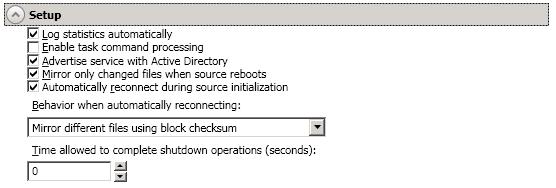Automatically reconnect during source initialization—Disk queues are user configurable and can be extensive, but they are limited. If the amount of disk space specified for disk queuing is met, additional data would not be added to the queue and data would be lost. To avoid any data loss, Double-Take Availability will automatically disconnect jobs when necessary. If this option is enabled, Double-Take Availability will automatically reconnect any jobs that it automatically disconnected. These processes are called auto-disconnect and auto-reconnect and can happen in the following scenarios.
- Exhausted queues on the source—If disk queuing is exhausted on the source, Double-Take Availability will automatically start disconnecting jobs. This is called auto-disconnect. The transaction logs and system memory are flushed allowing Double-Take Availability to begin processing anew. The auto-reconnect process ensures that any jobs that were auto-disconnected are automatically reconnected. Then, if configured, Double-Take Availability will automatically remirror the data. This process is called auto-remirror. The remirror re-establishes the target baseline to ensure data integrity, so disabling auto-remirror is not advised.
- Exhausted queues on the target—If disk queuing is exhausted on the target, the target instructs the source to pause. The source will automatically stop transmitting data to the target and will queue the data changes. When the target recovers, it will automatically tell the source to resume sending data. If the target does not recover by the time the source queues are exhausted, the source will auto-disconnect as described above. The transaction logs and system memory from the source will be flushed then Double-Take Availability will auto-reconnect. If configured, Double-Take Availability will auto-remirror. The remirror re-establishes the target baseline to ensure data integrity, so disabling auto-remirror is not advised.
- Queuing errors—If there are errors during disk queuing on either the source or target, for example, Double-Take Availability cannot read from or write to the transaction log file, the data integrity cannot be guaranteed. To prevent any loss of data, the source will auto-disconnect and auto-reconnect. If configured, Double-Take Availability will auto-remirror. The remirror re-establishes the target baseline to ensure data integrity, so disabling auto-remirror is not advised.
- Target server interruption—If a target machine experiences an interruption (such as a cable or NIC failure), the source/target network connection is physically broken but both the source and target maintain the connection information. The Double-Take Availability source, not being able to communicate with the Double-Take Availability target, stops transmitting data to the target and queues the data changes, similar to the exhausted target queues described above. When the interruption is resolved and the physical source/target connection is reestablished, the source begins sending the queued data to the target. If the source/target connection is not reestablished by the time the source queues are exhausted, the source will auto-disconnect as described above.
- Target service shutdown—If the target service is stopped and restarted, there could have been data in the target queue when the service was stopped. To prevent any loss of data, the Double-Take service will attempt to persist to disk important target connection information (such as the source and target IP addresses for the connection, various target queue information, the last acknowledged operation, data in memory moved to disk, and so on) before the service is stopped. If Double-Take Availability is able to successfully persist this information, when the Double-Take service on the target is restarted, Double-Take Availability will pick up where it left off, without requiring an auto-disconnect, auto-reconnect, or auto-remirror. If Double-Take Availability cannot successfully persist this information prior to the restart (for example, a server crash or power failure where the target service cannot shutdown gracefully), the source will auto-reconnect when the target is available, and if configured, Double-Take Availability will auto-remirror. The remirror re-establishes the target baseline to ensure data integrity, so disabling auto-remirror is not advised.
If you are experiencing frequent auto-disconnects, you may want to increase the amount of disk space on the volume where the Double-Take Availability queue is located or move the disk queue to a larger volume.
If you have changed data on the target while not failed over, for example if you were testing data on the target, Double-Take Availability is unaware of the target data changes. You must manually remirror your data from the source to the target, overwriting the target data changes that you caused, to ensure data integrity between your source and target.
Behavior when automatically reconnecting—If you have enabled automatic reconnections, you need to specify how Double-Take Availability will perform a remirror after an automatic reconnect has occurred.
- Do not mirror—Do not mirror any files after an automatic reconnect. If you select this option, the state of the job will remain pending after the auto-reconnect until a mirror is started manually.
- Mirror different files using block checksum—Any file that is different on the source and target based on date, time, and/or size is flagged as different. The mirror then performs a checksum comparison on the flagged files and only sends those blocks that are different.
- Mirror all files—All files are sent to the target.
- Mirror different files—Any file that is different on the source and target based on date, time, and/or size is sent to the target.
- Mirror only newer files—Only those files that are newer on the source are sent to the target.
Database applications may update files without changing the date, time, or file size. Therefore, if you are using database applications, you should use the file differences with checksum or mirror all option.


